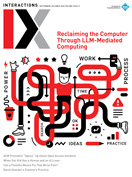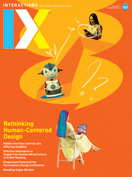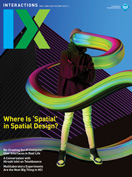Table of Contents
VOLUME XXXII.5 September - October 2025
-
WELCOME
-
Open, Mediated, and Ergonomic Interactions
Elizabeth F. Churchill, Mikael Wiberg
Welcome to the September–October issue of Interactions. In it, we cover ACM's move to open access, LLM-mediated computing, and ergonomic design alternatives to one of the most ubiquitous interaction modalities—the computer mouse. Most Interactions contributors and readers will have heard that ACM is going to move to a new…
-
-
What are you reading?
-
What Are You Reading?
Carrie Yury

My son and husband gave me a Little Free Library (https://littlefreelibrary.org) last year. It's wonderful. Having access to it is like having a hummingbird feeder but for humans. Although we are technically providing a service to the neighborhood, what we get in return is the delight of observing our…
-
-
Blog@IX
-
Why AI Cannot Learn South Asian Cities
Nusrat Jahan Mim

At just 19, the dabbawala who calls himself Junior Sharruk navigates the labyrinthine streets of Mumbai with astonishing precision. Adopting his name in homage to the 59-year-old Bollywood icon Shah Rukh Khan, Sharruk is a recent addition to Mumbai's renowned dabbawala network, an informal, human-coordinated logistics system composed of…
-
-
Columns
-
When Our Kid Has a Human and an AI Lover: A Conversation with Alexandra Diening on the Future of Relationships
Jie Li

Alexandra Diening, cofounder of the Human-AI Symbiosis Alliance, and I were having a group dinner on a warm March evening in Abu Dhabi, during the Augmented Humans 2025 Conference. (Full disclosure: Diening is my manager at H-AISA.) We were discussing the interesting papers and demos we had seen about…
-
Changing Art: How Technology Is Shifting How Art Is Made, Sold, and Experienced
Daria Loi

As a practicing artist and gallery owner, I experience daily how technology continues to shift artistic endeavors, as many have reported before me [1]. In this column, I review five transformations and what they mean for artists, collectors, art trade, and art in general. First, digital technologies have changed…
-
Outfitting the Emperor with New Clothes: How Human-Centered Design Can Reimagine AI to Minimize Its Risk
Ovetta Sampson

The airport was on fire. It was January 2012, and I was working as an international writer and photographer. A group of doctors and I were traveling from Kaduna State in northern Nigeria to the country's capital, Lagos. Nigerian President Jonathan Goodluck had just removed the fuel subsidy, and…
-
-
Forums
-
Child-Centered AI: Contextualizing Principles and Design in HCI
Ge Wang, Ayça Atabey, Kaiwen Sun, Grace C. Lin, Samantha-Kaye Johnston, Kruakae Pothong, Cara Wilson, Lachlan D. Urquhart, Jason C. Yip, Jun Zhao

AI technologies are increasingly integrated into the daily lives of children, encompassing tools that include learning platforms, interactive robots, and generative AI systems. This has spurred growing interest in HCI and related fields that emphasize the development of AI systems that prioritize children's best interests. In the summer of…
-
Signals Through the Storm: Designing Networks for Mutual Aid Communities in Southeast Louisiana
Jen Liu, Monique Verdin, Ozone504

As human-induced climate crises unfold on a planetary scale, climate-related disasters are becoming more intense and frequent. These events pose critical challenges and vital opportunities for ways in which researchers and practitioners need to approach computing systems in an era shaped by ecological disruption. Floods, storms, and wildfires, for…
-
Moving from Fairness to Justice: Intentional Algorithmic Solutions Through an Intersectional Lens
Kenya S. Andrews

After studying machine learning fairness for some time, I noticed that many of the experiences of Black women and Black men were not being captured as injustices or harms when they should have been. When ML tools are used to gauge their affinity toward bias, they employ fairness metrics—mathematical…
-
-
Features
-
Flexible Ergonomics: Can a Flexible Mouse Fix That Wrist Pain?
Jose Berengueres, Tony Yu

Since its first public appearance in 1968, the computer mouse has fundamentally maintained its original three buttons and its rigid form factor. And since then, computer users have only increased the amount of time they spend interacting with this device, with the mouse being used "almost three times as…
-
Where the Embodiment Is: Designing Felt Representations of Data
Laura J. Perovich, Ilya Vidrin, Nicole Zizzi

The importance of data in society—and its volume—has increased drastically over the past few decades. Data plays a central role in our infrastructures, health systems, and knowledge production processes. It is also increasingly tied up in civic life and used to make decisions about matters that affect us all,…
-
Seven Challenges in Designing for Office Well-Being
Hans Brombacher, Steven Vos, Steven Houben

The modern office has never been smarter. Building management systems adjust lighting and temperature based on occupancy patterns. Dashboards and digital platforms provide real-time metrics on air quality, productivity, and energy efficiency. Wearable devices track steps, posture, and stress levels. On the surface, it appears that technology is poised…
-
-
Cover story
-
Reclaiming the Computer through LLM-Mediated Computing
Mattias Rost

Ever since the desktop metaphor came about at Xerox PARC in the 1970s, we have interacted with computers that present themselves and their capabilities with what they display on-screen. Digital interaction has been organized around applications: isolated silos of functionality that users must manually operate, switch between, and coordinate.…
-
-
Calendar
-
Calendar
INTR Staff

September MuC '25: Mensch und Computer (Chemnitz, Germany) Aug 31–Sept 3, 2025 https://muc2025.mensch-und-computer.de/en 4S '25: Meeting of the Society for Social Studies of Science (Seattle, WA, USA) Sept 3–6, 2025 https://4sonline.org/meeting.php INTERACT '25: 20th IFIP TC13 International Conference on Human-Computer Interaction (Belo Horizonte, Brazil) Sept 8–12, 2025 https://interact2025.org Automotive…
-
-
Exit
-
Algorithmic Authenticity: David Szauder’s Visionary Practice
Scott Minneman, Renato Verdugo
.jpg)
Contributor: David Szauder Curators: Scott Minneman and Renato Verdugo Szauder's haunting "Anatomy Sweaters" surface the vulnerable interiors we all share. David Szauder's digital art occupies a unique space between deeply personal narratives, technical experimentation, and precedent. His creative method often involves gathering emotionally resonant material first, including digitized Super…
-
-
Conversations in Sketch
-
Joining the Dots
Abd Alsattar Ardati, Andrea Moed, Miriam Sturdee

"If we don't join the dots, digital poverty will keep slipping through the cracks." Authors Interview by Abd Alsattar Ardati, lecturer in social justice and digital poverty at the University of St Andrews. Illustrations by Andrea Moed, independent artist and researcher. Conversations in Sketch is curated by Miriam…
-
-
Voices
-
Josh Andres
Josh Andres

How would you describe your career trajectory and current role? My career in technology spans over 20 years across industry, industrial research, and academia. I've worked as a UX/UI designer creating multidevice experiences across the Asia-Pacific, as an HCI researcher and UX designer at IBM Research Australia, and now…
-
-
Waves
-
Speculative AI Prototyping: From Measuring Bodies to Confronting Ideals
Maria Luce Lupetti, Dave Murray-Rust, Serena Cangiano, Alice Mela

AI is changing the nature of the things that we design, the way we design them, and the futures we might be designing for. As AI becomes increasingly integrated into how products and services function and interact with world, as well as a tool within design processes, designers and…
-
-
Message from the President
-
Open Science, Open Access
Yannis Ioannidis

ACM will transition to a fully open access (OA) publishing model starting in January 2026, expanding access to computing research worldwide. Contributors and readers of Interactions have asked what this change means for them and how it will affect our publishing process. Elizabeth F. Churchill and Mikael Wiberg, the…
-


